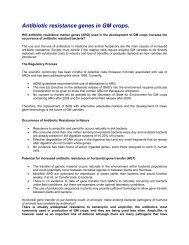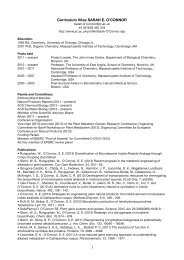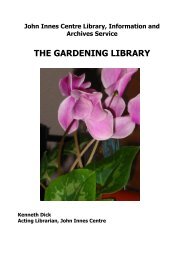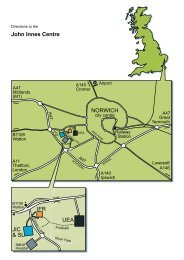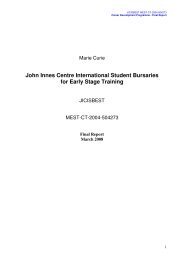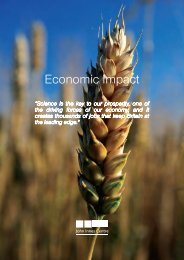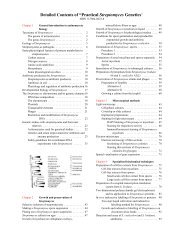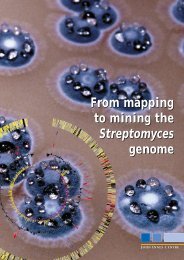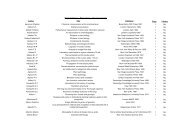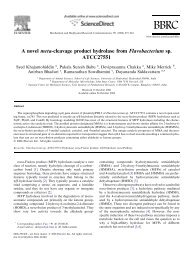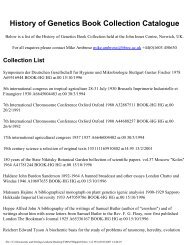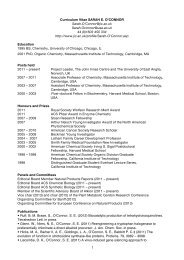1910s Timeline - John Innes Centre
1910s Timeline - John Innes Centre
1910s Timeline - John Innes Centre
You also want an ePaper? Increase the reach of your titles
YUMPU automatically turns print PDFs into web optimized ePapers that Google loves.
valuable information on scab<br />
resistance.<br />
In 1946 five of JIHI’s seedling<br />
cherries (Merton Favourite,<br />
Merton Heart, Merton Premier,<br />
and Merton Bounty) in the<br />
National Fruit Trials at the Kent<br />
Farm Institute are given awards<br />
by the Royal Horticultural<br />
Society. These seedlings were<br />
raised in 1921-3. It has taken<br />
about 25 years to determine<br />
their commercial possibilities.<br />
1940 Outdoor Tomato trials<br />
and breeding begin<br />
In 1940 raising tomatoes out of<br />
doors is a relatively new<br />
practice; traditionally tomatoes<br />
are grown in glasshouses. The<br />
Pomology Department at JIHI<br />
begins a series of experiments<br />
on varieties of tomatoes grown<br />
out of doors to determine yield,<br />
times of maturity, and other<br />
characters. These form part of<br />
an experiment to compare the<br />
best varieties and the best F 1<br />
hybrids with a view to using<br />
hybrid vigour in practical<br />
cultivation. Altogether 45<br />
varieties are grown and the<br />
results of the trials are published<br />
as <strong>John</strong> <strong>Innes</strong> Leaflet no. 5<br />
(1942). The breeding<br />
programme aims to bring<br />
forward tomato maturing dates<br />
to make outdoor growing<br />
viable; breeding and selection<br />
with bush and dwarf forms to<br />
produce a new type is also in<br />
progress. In 1947 work begins on<br />
rogue tomatoes (off-type<br />
plants); the aim is to reduce the<br />
percentage of rogues in tomato<br />
crops by determining the<br />
genetic or physiological cause.<br />
One of the successful varieties<br />
raised at Merton is ‘Puck’, a<br />
dwarf tomato released in 1946<br />
and notable for its good pollen<br />
and fruit setting qualities even<br />
in low-temperature conditions.<br />
Puck is later used as a parent,<br />
particularly in Canada, to<br />
introduce these characters into<br />
other tomatoes.<br />
1940-48 Kenneth Mather and<br />
associates develop statistical<br />
approaches to genetic analysis<br />
In 1940 Mather is two years into<br />
his appointment as Head of the<br />
newly formed Department of<br />
Genetics at JIHI. Since<br />
beginning his career he has<br />
gained experience in<br />
chromosomes from C. D.<br />
Darlington, in plant breeding<br />
techniques from J. V.<br />
Rasmusson at Svalöf in Sweden,<br />
in statistics and experimental<br />
design from R. A. Fisher at<br />
University College, London, and<br />
in Drosophila genetics and<br />
evolutionary theory from A. H.<br />
Sturtevant and T. Dobzhansky<br />
in California.<br />
Mather’s consuming interest is<br />
in the genetics of quantitative<br />
characters. Early in his career,<br />
plant breeder Sir Frank<br />
Engledow told him: ‘If you are<br />
interested in genetics and want<br />
to help the plant breeder you<br />
should study the inheritance of<br />
quantitative characters such as<br />
yield and height’ and this<br />
message has been reinforced<br />
through Mather’s association<br />
with Svalöf and with Fisher.<br />
Using Fisher’s statistical<br />
techniques, Mather sets himself<br />
the problem of analysing the<br />
genetics of quantitative<br />
variations. His aim is to answer<br />
questions of economic<br />
importance in plant breeding<br />
and, also, to further<br />
understanding of the role of<br />
quantitative variation in natural<br />
populations and the mechanism<br />
of evolution.<br />
Most existing selection and<br />
biometrical experiments so far<br />
have been done on a oneworker,<br />
one organism basis on<br />
subjects such as chickens, mice,<br />
fruit flies and maize. Mather’s<br />
diverse research background<br />
means he is able to take full<br />
Page 34 of 91



